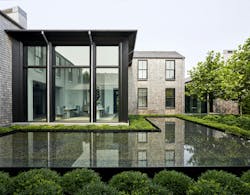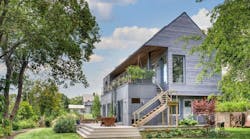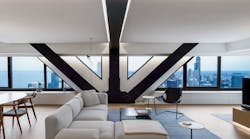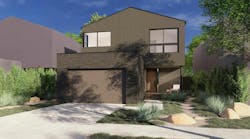Why Tradition and Innovation Aren't Opposites in Luxury Design
Builder in 5 is our five-question series with the minds behind standout custom homes.
Today, in our first Builder in 5 with an architect, we chat with Margie Lavender, partner at Kligerman Architecture & Design. Her Manhattan firm is known for residential work that reinterprets tradition with modern detail: glass expanses, sculptural forms and projects that feel both timeless and contemporary.
The goal is to make each project feel timeless, not time-bound.
- Margie Lavender, partner, Kligerman Architecture & Design
1. Your work blends traditional craftsmanship with modern forms. How do you decide where to honor the past and where to push into new territory?
Margie Lavender: We don’t see tradition and innovation as opposites; they’re partners in an ongoing conversation. Tradition gives us a vocabulary, a sense of proportion, restraint, and beauty that endures. Innovation is how we make that vocabulary speak in the present tense.
The choice of where to honor the past or push forward usually comes from context. In a historic setting, we might lean into classic craftsmanship and subtle reinterpretation. On a dramatic site with a bold client, we may let modernity and sculptural volumes lead. The goal is to make each project feel timeless, not time-bound, and to create buildings that feel as if they’ve always been there, even if their details are distinctly of today.
2. Tell us about a project where you took a design risk. How did it play out, and what can other builders, architects, and designers learn from that experience?
Lavender: One of our most rewarding risks came on a project where we paired a classically proportioned shingled form with a thoroughly modern glass pavilion. The juxtaposition might sound heretical, but it proved remarkably successful. Set within a reflecting pool, the glass pavilion became a luminous, sculptural counterpoint to the more austere, almost Shaker-like simplicity of the shingled forms, and an expression of the modern lives within.
The transition between the two was conceived to celebrate contrast rather than conceal it. The lesson for any architect or builder is that risk succeeds only when it’s grounded in integrity of materials, intent, and collaboration.
3. What’s one decision—about materials, form, or process—that has come to define how you approach every project? How does it shape your collaboration with builders and clients?
Lavender: A defining decision in our work is to begin with form. We’re constantly asking: how does the building sit in the landscape, how does it catch the light, how do you move through it? Materials and ornament follow from that inquiry.
This approach shapes how we collaborate with clients and builders because it turns the process into a shared exploration rather than a checklist. We strive to engage the full project team as early as possible to understand every nuance and to bring together the creative and insightful thinking of all perspectives from the very start of design.
Clients relish spaces that flow effortlessly, connect to nature, and reflect their personal narratives.
- Margie Lavender, partner, Kligerman Architecture & Design
4. What shifts are you seeing among luxury clients today? How do these evolving priorities influence your approach?
Lavender: Our clients’ vision sets the direction for our designs, so the definition of luxury can be as unique as the client and ever evolving in response to changing tastes and aspirations. For some, its grandeur, while for others, it’s a jewel-box cottage that’s curated, exquisitely detailed, and deeply personal rather than expansive for the sake of scale.
A consistent thread today is an appreciation for authenticity, distinctiveness, and craft. Clients relish spaces that flow effortlessly, connect to nature, and reflect their personal narratives.
The more advanced the tools become, the more valuable the human touch feels,
- Margie Lavender, partner, Kligerman Architecture & Design
5. Looking ahead, what innovations or approaches do you think will define the next generation of luxury custom homes, and how are you experimenting with these ideas in your designs?
The future of custom residential design lies in integration between technology and craft, landscape and architecture, environment, and emotion. Stricter energy codes and a shifting ethos are creating greater opportunities to incorporate green building systems, with sustainability increasingly accepted as the norm rather than the exception. We are also consistently driven by client expectations to pursue quiet technology—smart homes that don’t feel futuristic, but simply intuitive and effortless.
Yet even within this context of innovation, we are always drawn to the handmade. The more advanced the tools become, the more valuable the human touch feels, in our drawings, in our materials, and in our carefully crafted spaces. We imagine the next generation of luxury homes as places where innovation enhances, rather than replaces, the poetic aspects of daily life.
For more insights from the field, read our earlier Builder in 5 interviews, and reach out with suggestions on who we should interview next.
In Case You Missed It...
About the Author
Pauline Hammerbeck
Pauline Hammerbeck is the editor of Custom Builder, the leading business media brand for custom builders and their architectural and design partners. She also serves as a senior editor for Pro Builder, where she directs products coverage and the brand's MVP Product Awards. With experience across the built environment - in architecture, real estate, retail, and design - Pauline brings a broad perspective to her work. Reach her at [email protected].






